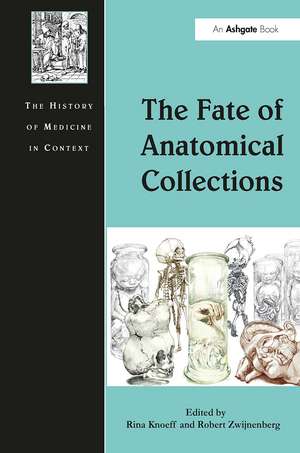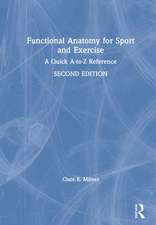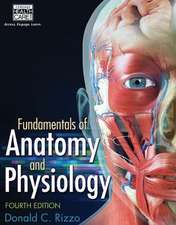The Fate of Anatomical Collections: The History of Medicine in Context
Autor Rina Knoeff, Robert Zwijnenbergen Limba Engleză Paperback – 14 oct 2024
| Toate formatele și edițiile | Preț | Express |
|---|---|---|
| Paperback (1) | 263.15 lei 6-8 săpt. | |
| Taylor & Francis – 14 oct 2024 | 263.15 lei 6-8 săpt. | |
| Hardback (1) | 1006.77 lei 6-8 săpt. | |
| Taylor & Francis – 4 mar 2015 | 1006.77 lei 6-8 săpt. |
Din seria The History of Medicine in Context
-
 Preț: 311.70 lei
Preț: 311.70 lei -
 Preț: 311.41 lei
Preț: 311.41 lei -
 Preț: 310.41 lei
Preț: 310.41 lei -
 Preț: 386.77 lei
Preț: 386.77 lei - 13%
 Preț: 338.33 lei
Preț: 338.33 lei -
 Preț: 489.26 lei
Preț: 489.26 lei -
 Preț: 492.53 lei
Preț: 492.53 lei -
 Preț: 469.34 lei
Preț: 469.34 lei - 18%
 Preț: 1000.27 lei
Preț: 1000.27 lei -
 Preț: 323.23 lei
Preț: 323.23 lei - 25%
 Preț: 824.80 lei
Preț: 824.80 lei - 18%
 Preț: 1054.71 lei
Preț: 1054.71 lei -
 Preț: 489.26 lei
Preț: 489.26 lei - 17%
 Preț: 819.35 lei
Preț: 819.35 lei - 22%
 Preț: 324.16 lei
Preț: 324.16 lei -
 Preț: 497.92 lei
Preț: 497.92 lei - 26%
 Preț: 764.20 lei
Preț: 764.20 lei -
 Preț: 469.34 lei
Preț: 469.34 lei -
 Preț: 486.76 lei
Preț: 486.76 lei - 25%
 Preț: 823.44 lei
Preț: 823.44 lei - 5%
 Preț: 464.79 lei
Preț: 464.79 lei - 18%
 Preț: 1009.74 lei
Preț: 1009.74 lei - 18%
 Preț: 1054.71 lei
Preț: 1054.71 lei - 17%
 Preț: 346.02 lei
Preț: 346.02 lei - 5%
 Preț: 1158.84 lei
Preț: 1158.84 lei -
 Preț: 489.26 lei
Preț: 489.26 lei -
 Preț: 469.34 lei
Preț: 469.34 lei - 18%
 Preț: 1113.12 lei
Preț: 1113.12 lei - 18%
 Preț: 1055.51 lei
Preț: 1055.51 lei -
 Preț: 469.34 lei
Preț: 469.34 lei - 26%
 Preț: 765.04 lei
Preț: 765.04 lei -
 Preț: 489.26 lei
Preț: 489.26 lei - 18%
 Preț: 1008.17 lei
Preț: 1008.17 lei - 18%
 Preț: 1006.77 lei
Preț: 1006.77 lei - 18%
 Preț: 1054.71 lei
Preț: 1054.71 lei
Preț: 263.15 lei
Preț vechi: 313.08 lei
-16% Nou
Puncte Express: 395
Preț estimativ în valută:
50.36€ • 52.28$ • 41.99£
50.36€ • 52.28$ • 41.99£
Carte tipărită la comandă
Livrare economică 24 martie-07 aprilie
Preluare comenzi: 021 569.72.76
Specificații
ISBN-13: 9781032921976
ISBN-10: 1032921978
Pagini: 328
Dimensiuni: 156 x 234 mm
Greutate: 0.61 kg
Ediția:1
Editura: Taylor & Francis
Colecția Routledge
Seria The History of Medicine in Context
Locul publicării:Oxford, United Kingdom
ISBN-10: 1032921978
Pagini: 328
Dimensiuni: 156 x 234 mm
Greutate: 0.61 kg
Ediția:1
Editura: Taylor & Francis
Colecția Routledge
Seria The History of Medicine in Context
Locul publicării:Oxford, United Kingdom
Public țintă
AcademicCuprins
I: Introduction; 1: Setting the Stage; 2: Organ Music; II: Fated Collections; 3: Quis Custodiet Ipsos Custodes? Or, What Richard Owen did to John Hunter's Collection; 4: Gender, Fate and McGill University's Medical Collections; 5: Resilient Collections; 6: Inside the Charnel House; III: Preparations, Models and Users; 7: Adieu Albinus; 8: User-Developers, Model Students and Ambassador Users; 9: Mapping Anatomical Collections in Nineteenth-Century Vienna; 10: Fall and Rise of the Roca Museum; IV: Provenance and Fate; 11: The Fate of the Beaded Babies; 12: ‘Not Everything that Says Java is from Java'; 13: Cataloguing Collections; V: Museum and Collection Practices Today; 14: Anatomical Craft; 15: Restoration Reconsidered; 16: From Bottled Babies to Biobanks; 17: Ball Pool Anatomy
Notă biografică
Rina Knoeff is a University Lecturer at the Faculty of Arts at the University of Groningen. She is particularly interested in the cultural history of medicine and chemistry. Previous work has centred on the Boerhaave school and on early modern Dutch anatomy and anatomical collections. Robert Zwijnenberg is Professor of Art and Science Interactions at Leiden University. He has published on Renaissance culture and art theory, philosophy of art, and on the relation between the arts and the life sciences. Zwijnenberg is one of the founding directors of The Arts and Genomics Centre.
Recenzii
"This is among the best collections available on the history of anatomy. It is organized in ways that promote thematic and theoretical readings while also allowing historical and geographical comparisons to be made. It is worth a seri-ous, cover-to-cover read by historians of medicine, natural history, and anatomy who are interested in the state of their field." - Carin Berkowitz, Chemical Heritage Foundation, Bulletin of the History of Medicine
"One of the strongest aspects of this book is its ability to furnish the reader with some fabulously random pieces of knowledge." - Heidi Nicholl, independent scholar
"One of the strongest aspects of this book is its ability to furnish the reader with some fabulously random pieces of knowledge." - Heidi Nicholl, independent scholar
Descriere
This volume explores the changing status of anatomical collections from the early modern period to date. It is argued that anatomical and pathological collections are medically relevant for future research, and are important in the history of medicine, the cultural history of the body, and the history of the institutions to which they belong. In co






